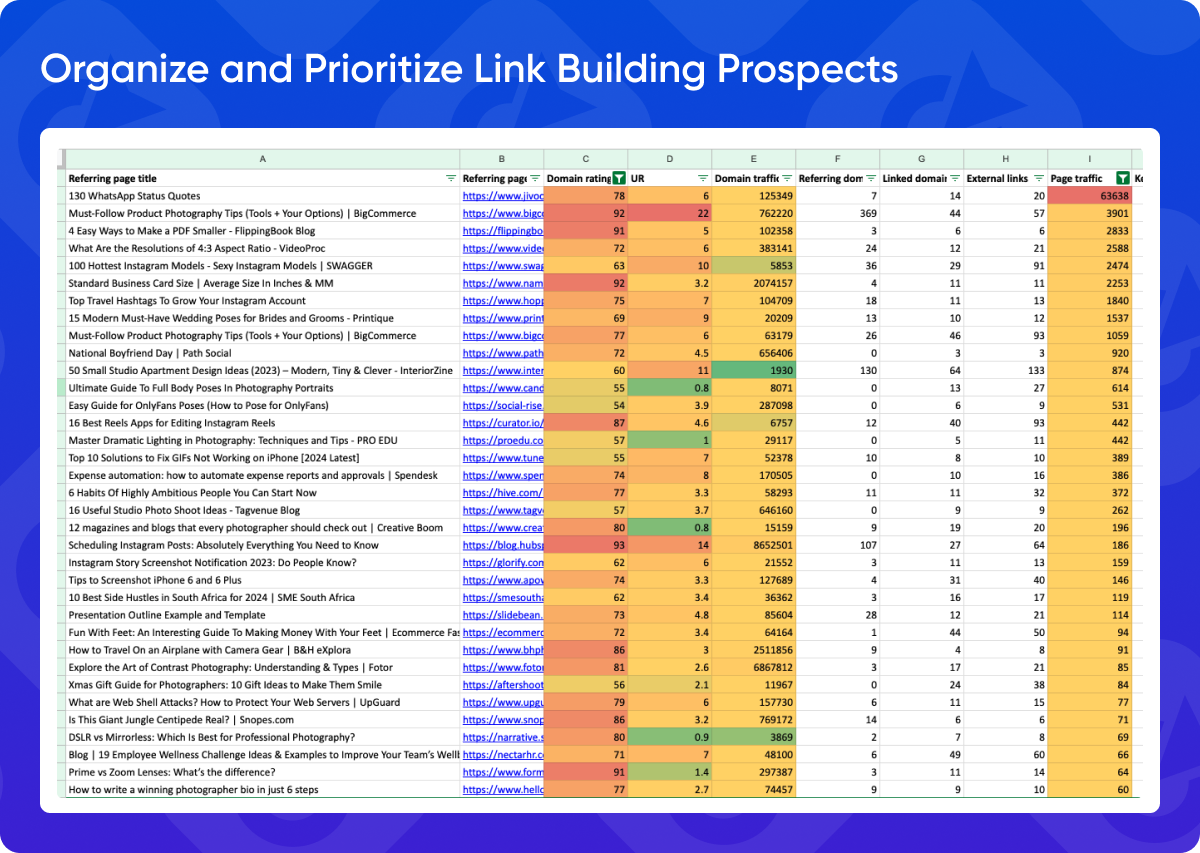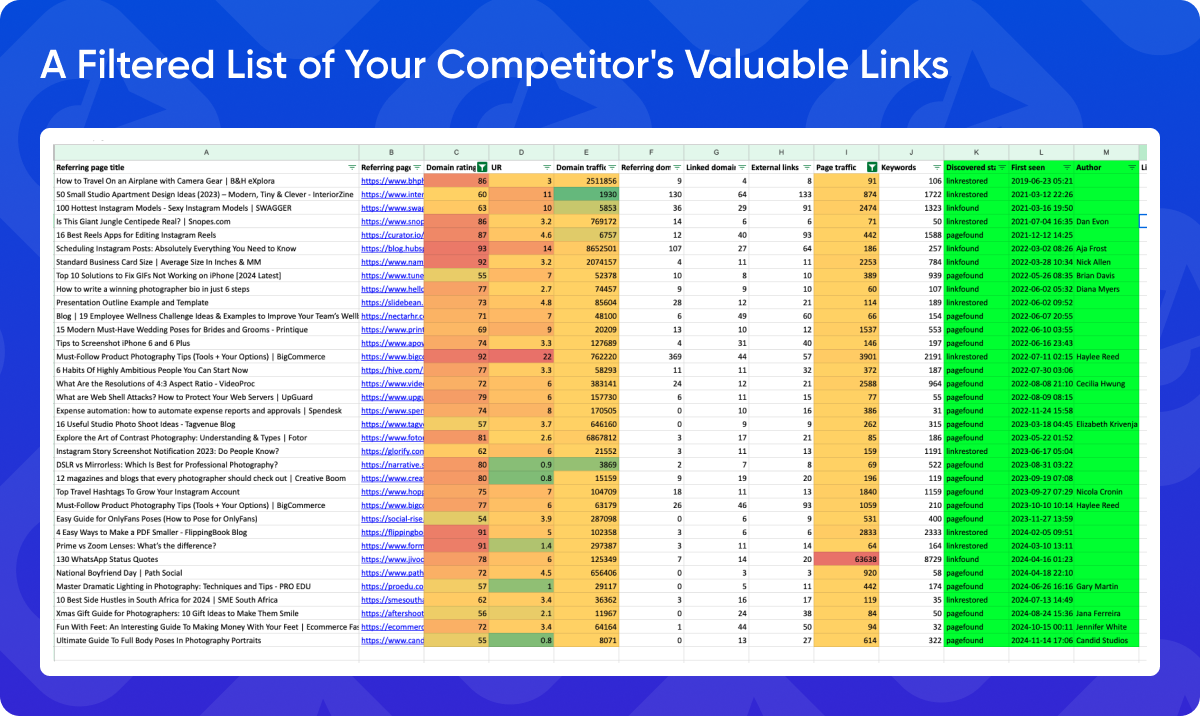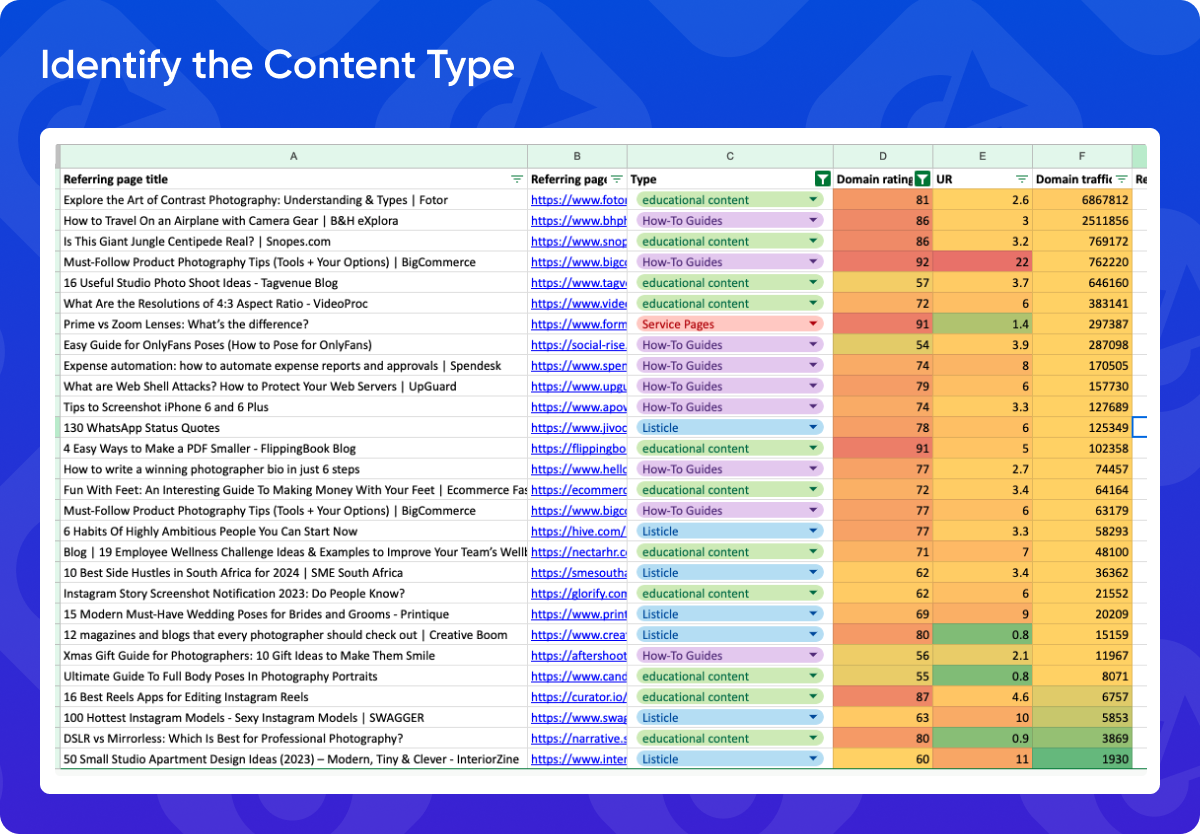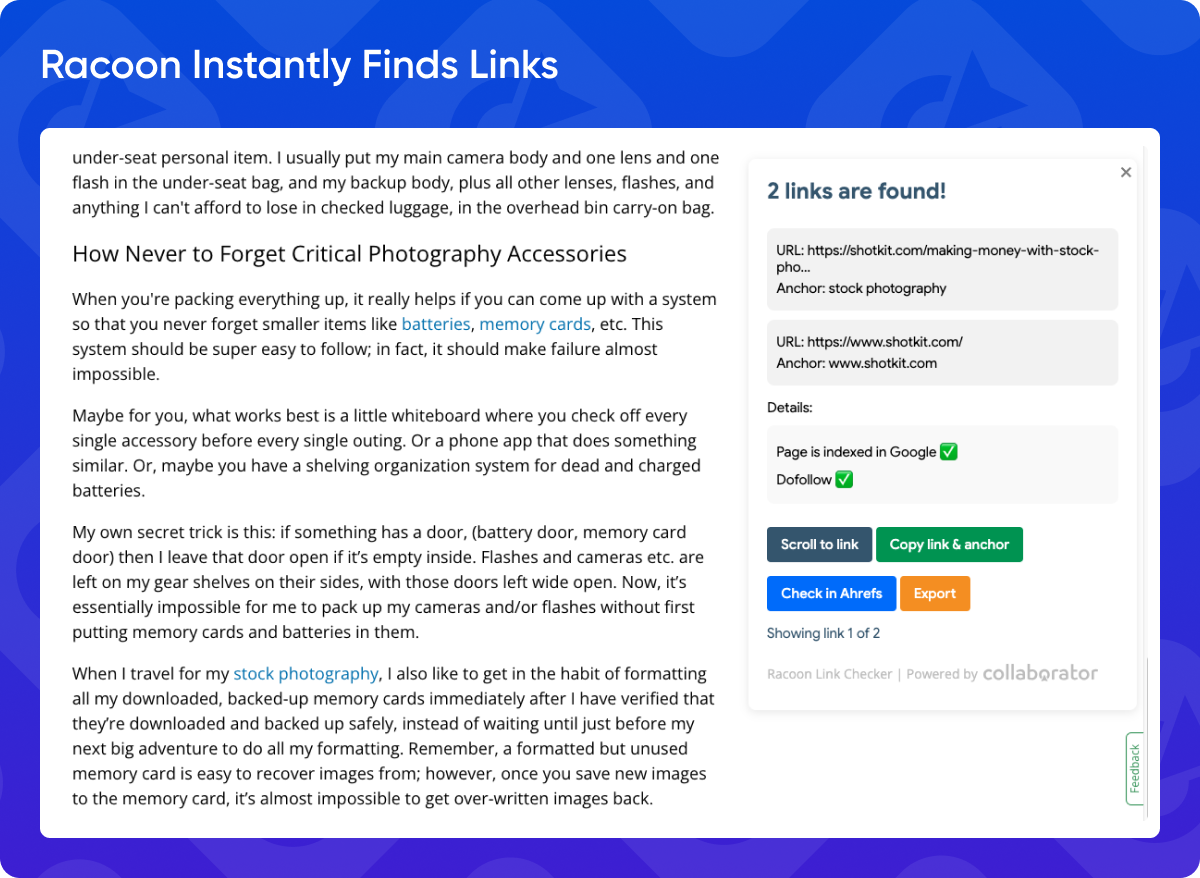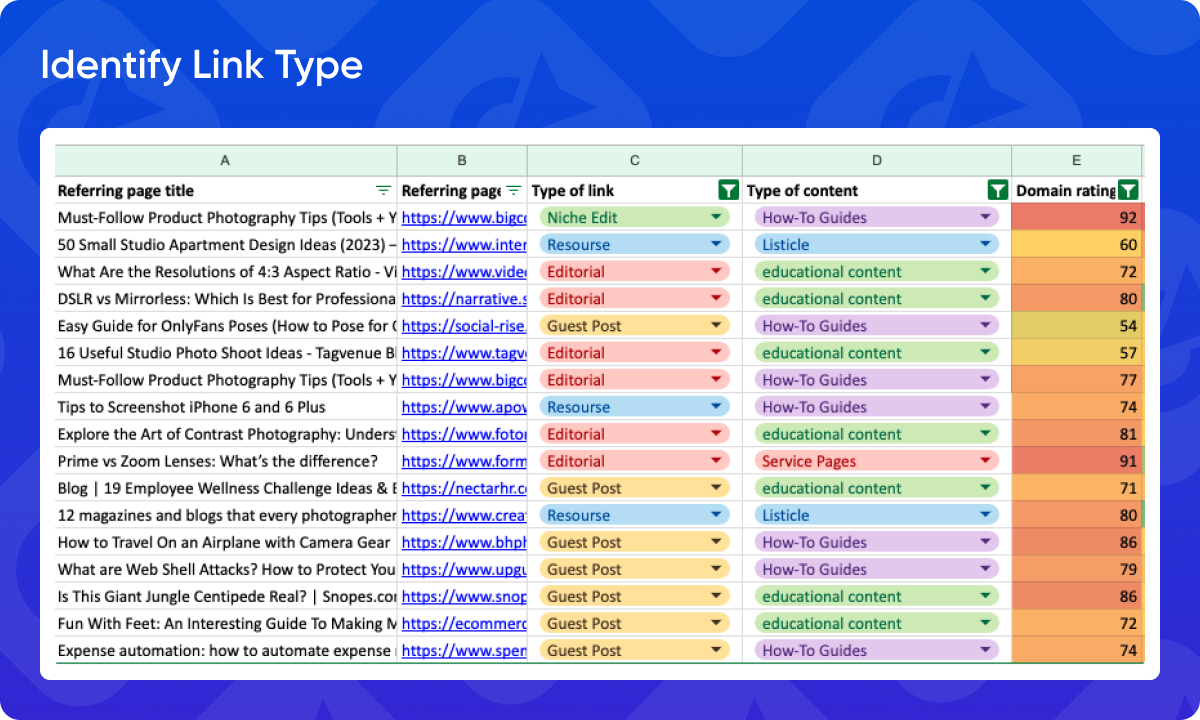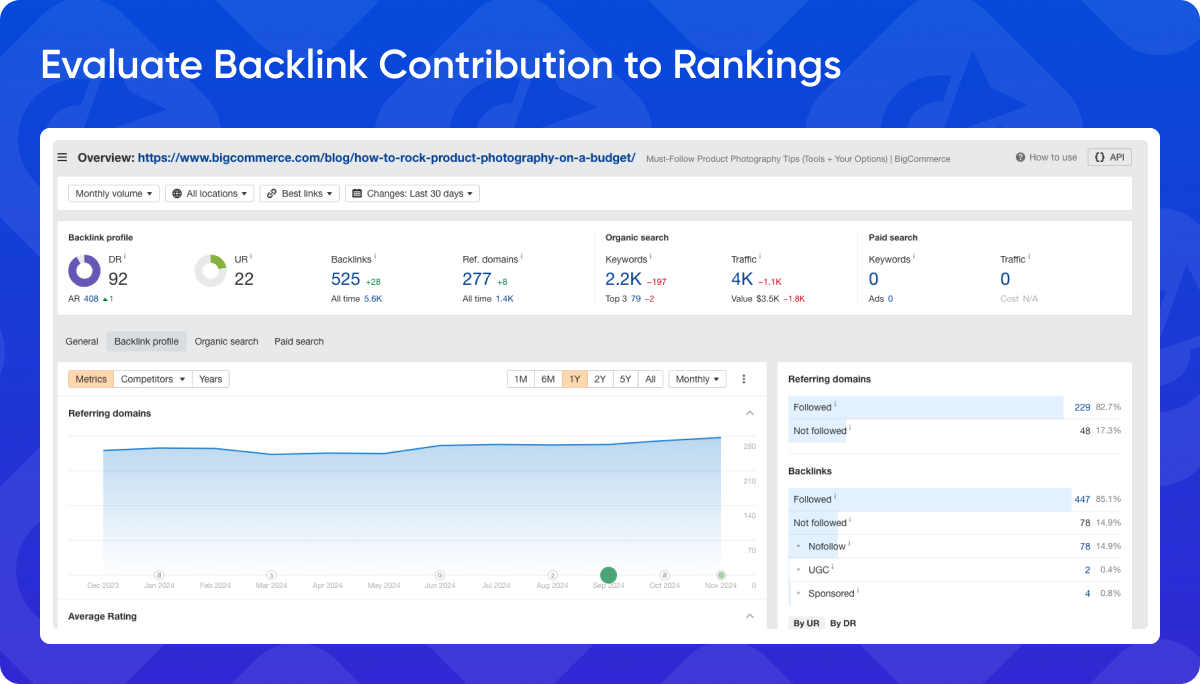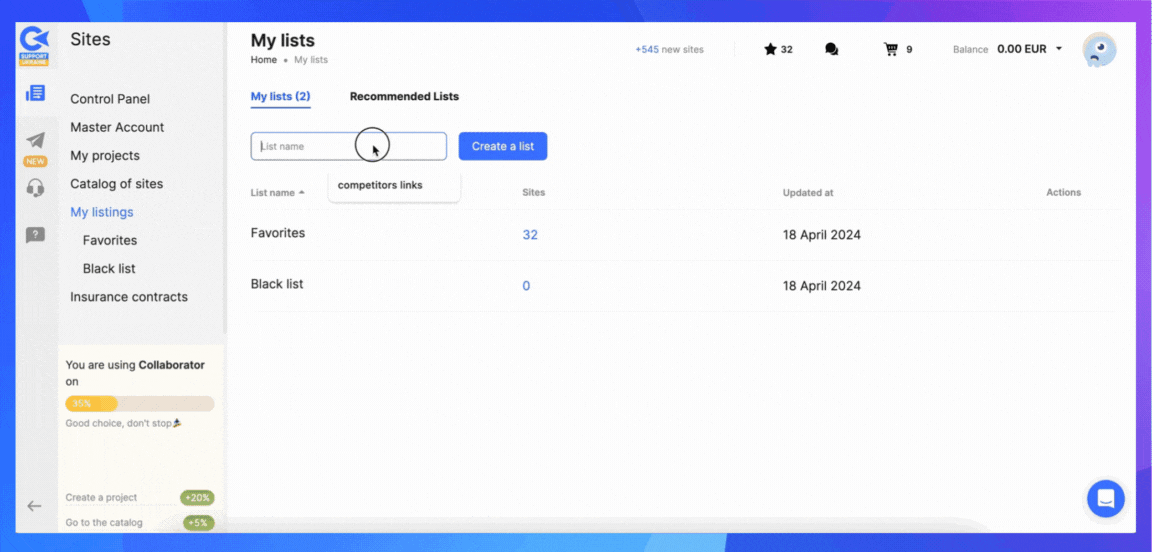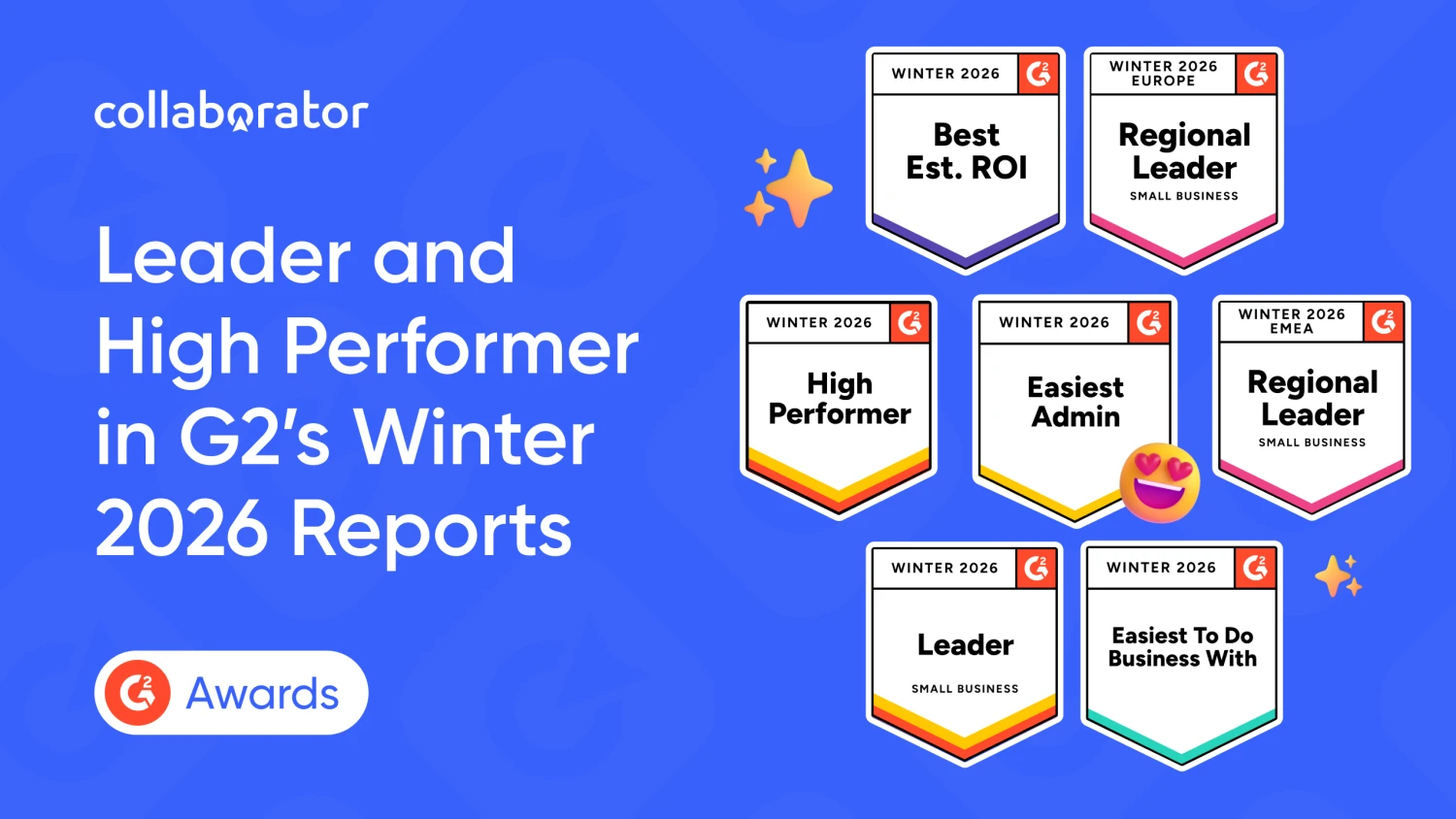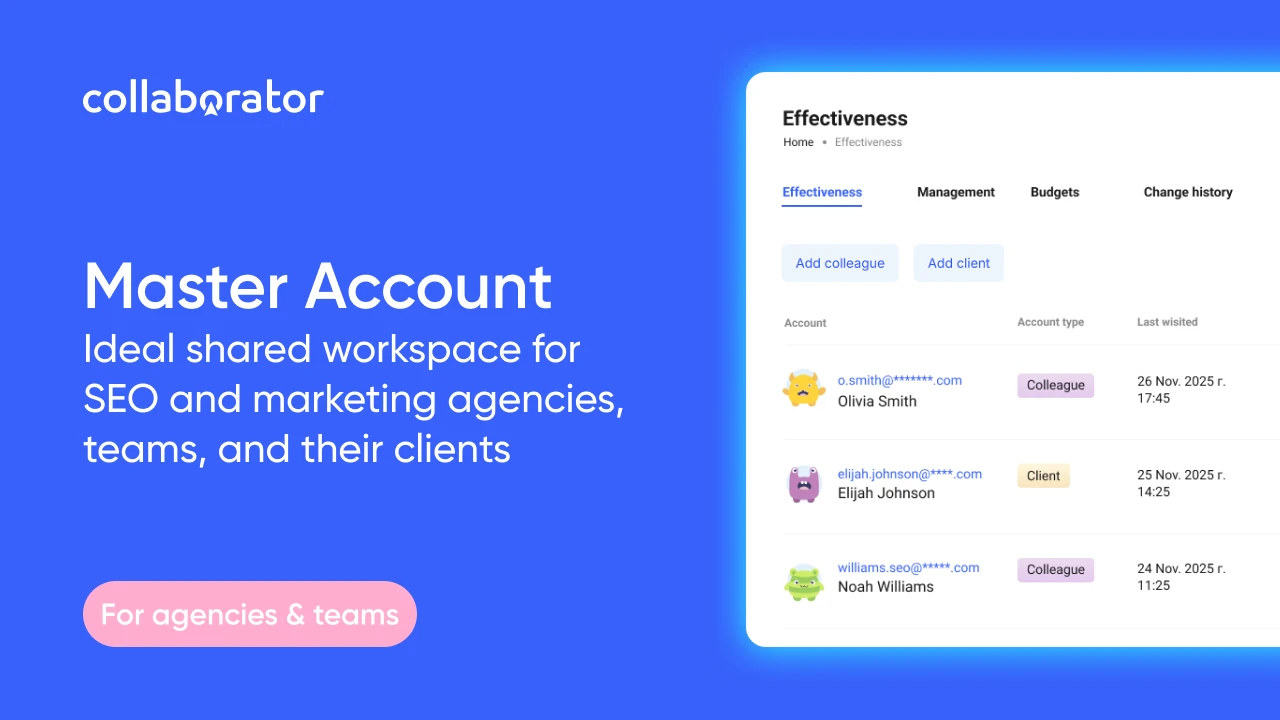
Learn how to ethically spy on your competition and leverage their link building strategies to boost your website's authority and rankings.
SEO professionals and link builders are always looking for effective, ethical, and scalable methods to strengthen their website’s backlink profile. However, ever-changing search engine algorithms and increasing competition make pinpointing strategies to outrank rivals challenging.
This is where competitive link analysis comes to the rescue.
Analyzing competitor strategies is an age-old marketing tactic. In link building, it works because your competitors have already done the heavy lifting — testing what works, what falls flat, and which channels deliver the best results.
But by studying competitor backlink profiles, you’re not just copying their homework; you’re reverse-engineering a success playbook.
Ready to learn how to spy on competitors' backlinks? Find out what competitive link analysis entails and follow our step-by-step guide to conduct your own.
Understanding Competitive Link Analysis
Competitive link analysis is the I-Spy of SEO. It requires examining your competitors' backlink profiles to identify the strategies contributing to their higher search engine rankings. This involves analyzing the types and quality of backlinks your competitors have acquired, the content that attracted those links, and the domains linking to them.
Top Competitor Link Analysis Tools
If done manually, competitor link analysis would be incredibly time-consuming and resource-intensive. However, numerous SEO tools are designed specifically for this purpose, with SEMrush, Ahrefs, and Majestic being three of the most popular.
Ahrefs
Ahrefs has a massive index that allows you to review your rival's daily, weekly, and monthly traffic data. Its Content Gap report shows you where your site may be lacking, making it easier to compete.
Key Features:
- Site Explorer: Analyzes backlinks, domain ratings, and the organic search performance of competitors.
- Content Explorer: Finds high-performing content linked by competitors to uncover trends.
Majestic
While SEMrush and Ahrefs offer numerous SEO tools, Majestic focuses only on backlink analysis services. It’s well known for its in-depth link metrics and historical data, which make measuring the quality of links simple.
Key Features:
- Trust Flow & Citation Flow: Metrics that evaluate the quality and quantity of backlinks.
- Backlink History: Tracks changes in backlink profiles over time.
These tools not only reveal the secrets of your competitors’ link-building strategies, but they also help you prioritize your link-building efforts to ensure you focus on high-value opportunities.
Popular Link Building Approaches
After using these tools to track competitors' links and analyze their impact, you can use the results to take one of two approaches to link building:
The Skyscraper Technique
SEO expert Brian Dean popularized the Skyscraper Technique, which requires creating content superior to the current high-ranking pieces to obtain their backlinks and outrank them in the search engine results pages (SERPs). The existing content is called “skyscraper” as it is the most-seen, and you need to topple it to ensure yours stands out more.
To use this method, you’ll need to spy on competitors' websites and identify popular, link-heavy articles using tools like Ahrefs or SEMrush.
Once done, you must create content that is even more detailed, engaging, visually appealing and includes updated data or expert insights that align with Google’s E-E-A-T guidelines. Then, reach out to websites linking to the original content, showcasing your improved resource and highlighting its value to their readers.
This method capitalizes on proven demand, offers genuine value, and improves backlink potential, making it a highly effective and scalable SEO strategy for boosting visibility and authority.
Broken Link Building
Broken link building could be described as competitive backlinking. It involves finding broken links on competitor websites and offering your content as a replacement.
Start by using tools like Ahrefs to scan competitor sites for 404 errors or dead links. Once you identify a broken link, determine the original content's topic and create a high-quality, updated version.
Thereafter, reach out to the website owner (in a personal email, if possible) to inform them of the broken link. Politely suggest your content as a better alternative and explain how it aligns with their audience’s interests. You can also emphasize that your content provides a more updated or comprehensive resource, which could enhance the value of their page, too.
This approach creates a win-win situation: It helps the website fix its links and provides a valuable backlink opportunity for your site. It also gives you the opportunity to establish a relationship for future collaborations.
Benefits of Competitive Link Analysis
There’s a reason why 90% of Fortune 500 companies use competitive intelligence to gain a competitive advantage, and 62% of companies plan to increase spending on competitive intelligence in the future. Analyzing the backlink profiles of top competitors offers numerous benefits, from cost-savings to improved collaborations:
- Finding high quality backlinks: If a competitor receives consistent backlinks from industry-leading websites, replicating this approach can significantly boost your site’s authority with Google. This approach turns guesswork into strategy, allowing you to leapfrog trial-and-error phases and focus directly on high-value link opportunities.
- Identifying gaps: If you know how to find competitors' links and discover they’re gaining valuable backlinks from trusted industry blogs or authoritative media outlets, you can reach out to the same sources with your own high-quality content or pitch to secure similar backlinks. This helps fill the gaps in your backlink profile and increases your website's authority and rankings.
- Revealing effective content strategies: By examining which types of content on competitor sites attract the most backlinks — whether it's data-driven posts, detailed guides, or engaging visual content — you can create similar niche content that is more likely to generate organic backlinks. This approach improves backlink quantity and enhances the relevance and quality of the links pointing to your site.
- Stay ahead of SEO trends: If you spy on competitors' websites and monitor their link-building strategies and collaborations, you can adapt quickly to shifts in SEO best practices and ensure your strategies remain competitive at all times.
- Improving collaborations: A competitor link analysis can help you find opportunities to collaborate with influencers, blogs, or platforms already connected to your competitors. When you already know that an individual or entity has an interest or connection to your niche, you can capitalize on this to your advantage.
- Saving time and resources: Instead of starting your link building strategy from scratch, you can focus your efforts on replicating or improving upon high-impact strategies that you already know work.
Step-By-Step Guide to Competitive Link Analysis
Now you know what competitive backlink analysis is, what tools to use, and the enormous benefits it offers, here’s how to spy on competitors' backlinks successfully:
Step 1: Identify Your Top Competitors
Start by conducting thorough keyword research to find which businesses are ranking for the same target keywords. Tools like Ahrefs provide valuable insights into which websites are showing up in your SERPs for those keywords, and chasing links through Ahrefs research is a common SEO tactic.
You can also use your industry knowledge to consider niche competitors — those that serve the same audience or offer similar products and services — even if they don’t always appear at the top of every search. This combination of data-driven research and market understanding will help you to pinpoint the most relevant competitors for analysis.
To use Ahrefs to find your competitors, enter your domain in Site Explorer and go to Organic Competitors. Then, export the results to an Excel or similar file and save it.
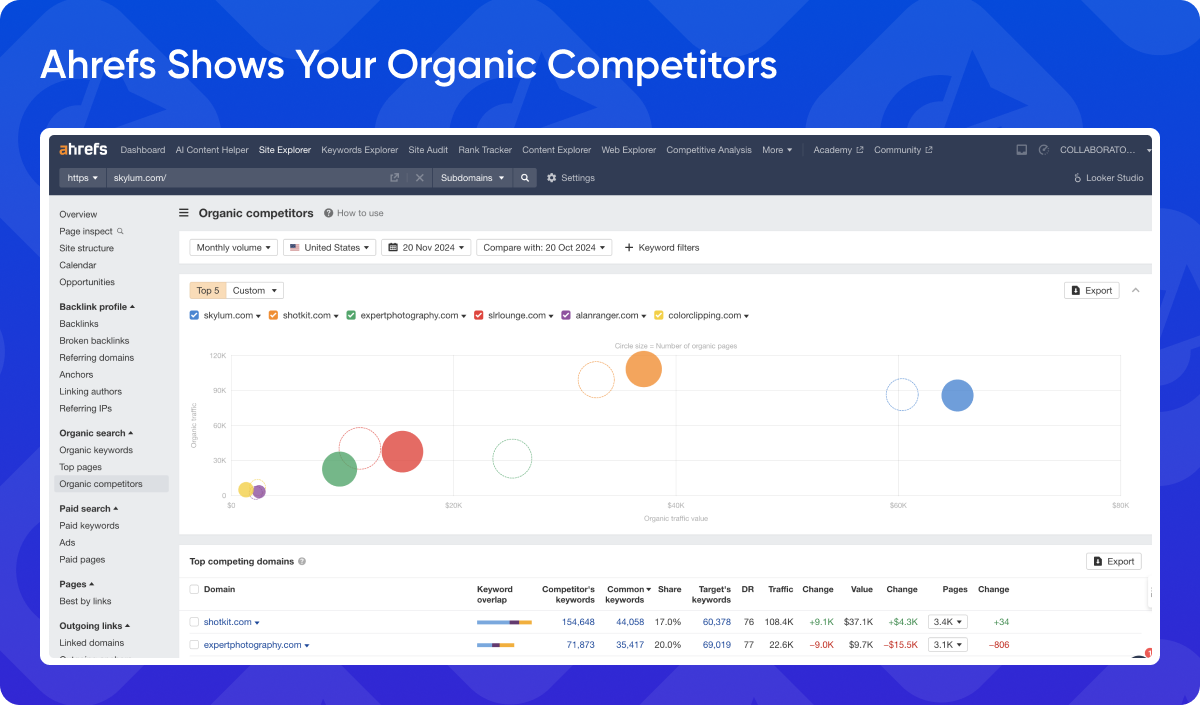
If your website has only recently gone live, you may not find any data listed in Organic Competitors. If this is the case, navigate to Keyword Explorer and try to identify your target competitors using your primary keywords.
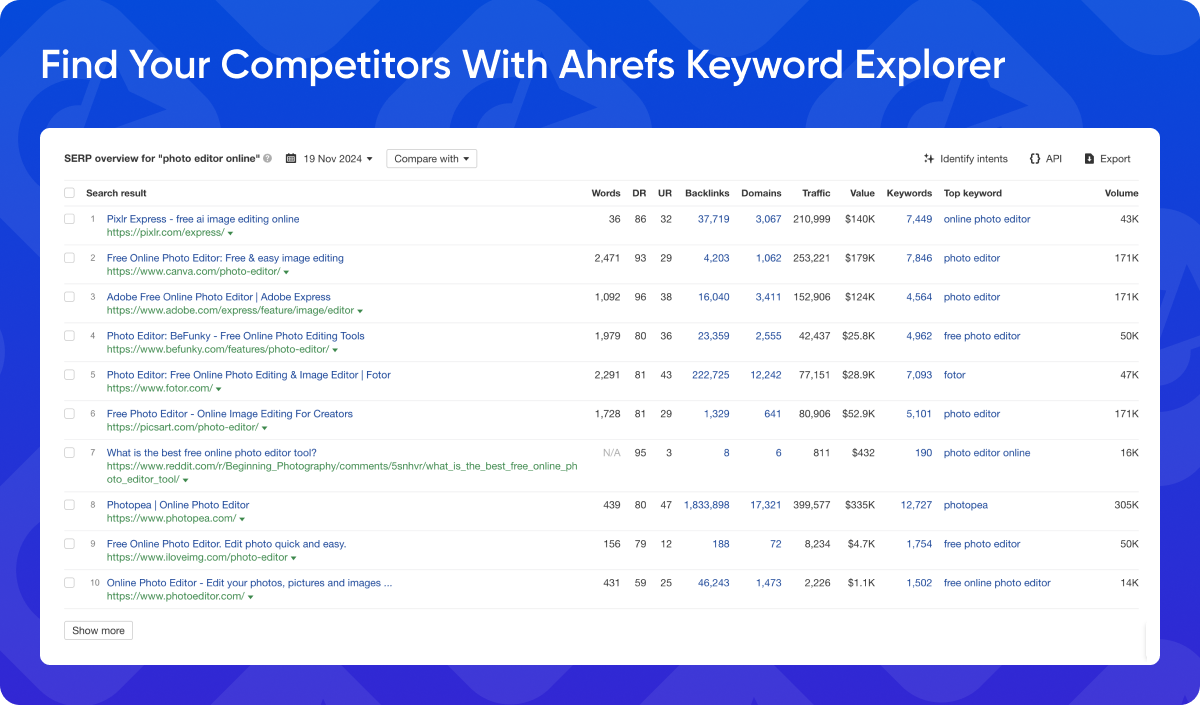
Step 2: Extract Competitor Backlink Profiles
To extract competitor backlink profiles using Ahrefs, enter the competitor’s domain into the Site Explorer tool, then navigate to the "Backlinks" section to see a comprehensive list of their inbound links. From there, you can filter results based on link type, authority, or relevance. You can then export the data for further analysis to identify high-quality backlink opportunities and potential link sources for your own website.
Use the filter "Best by Links." We recommend setting your filters to find competitors with dofollow links, a domain rating of 20, and traffic of 500. This criteria is relatively low because our goal is just to avoid spammy links rather than filter out suboptimal ones. You can use the feature differently if preferred. 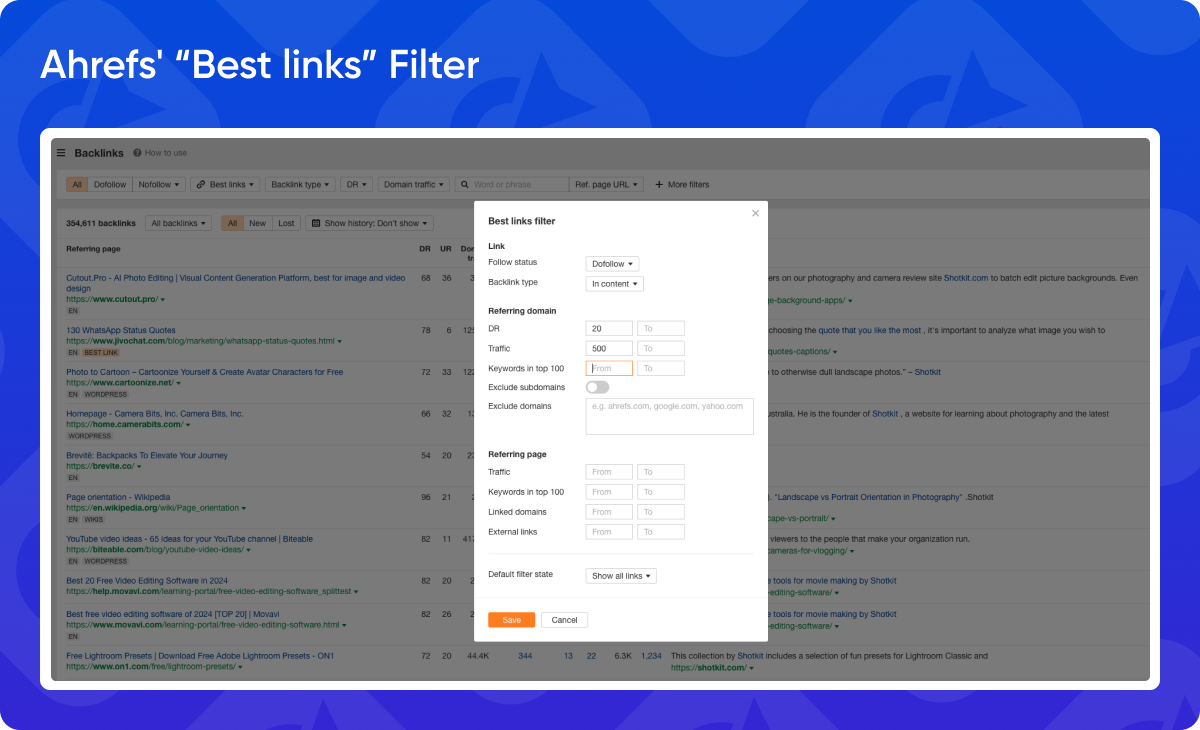
Below, you can see how the list of links look before and after applying the filter. Obviously, after using the filter, you can focus on the most relevant prospects.
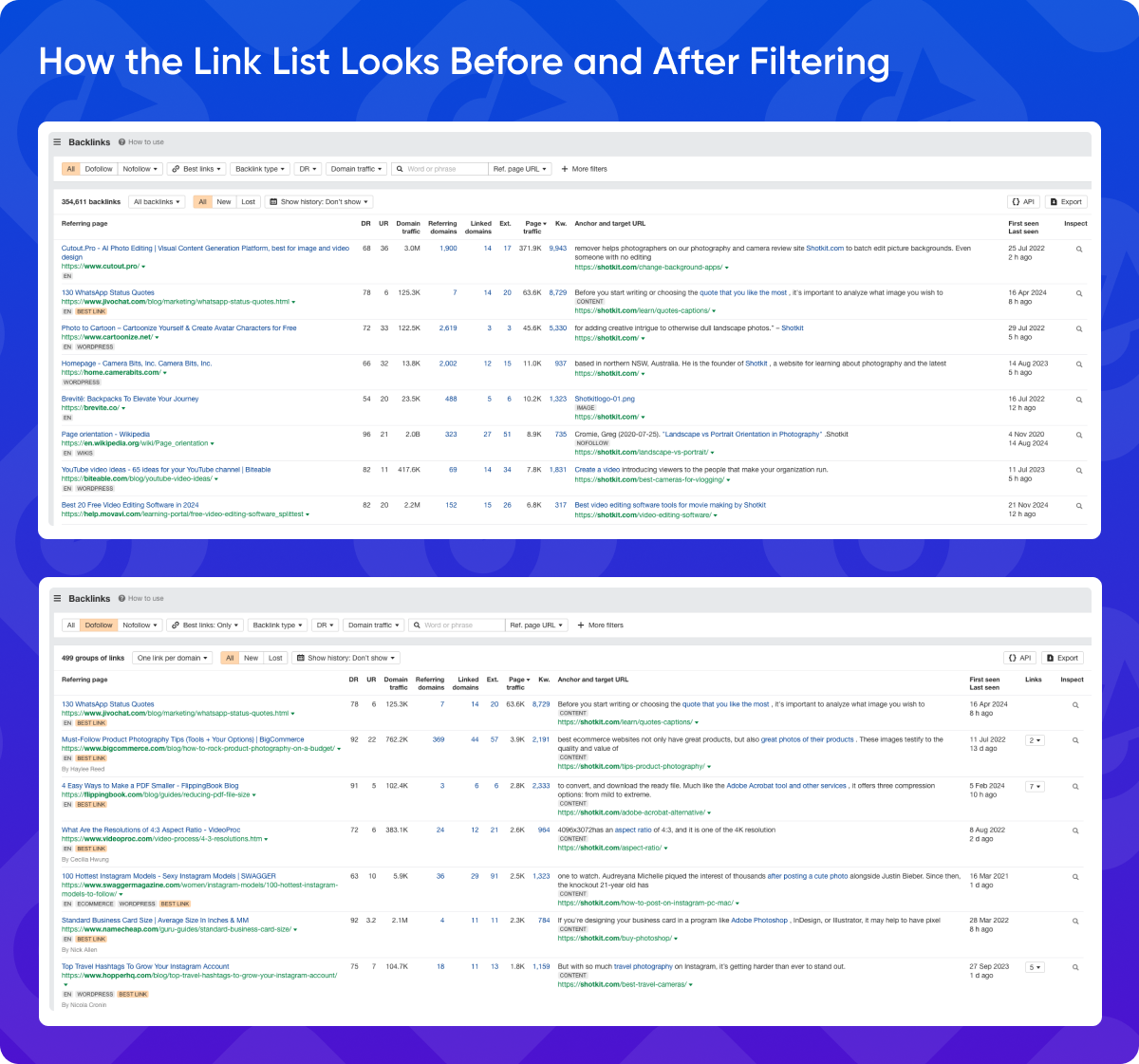
Steps to Organize and Prioritize Link Building Opportunities
Once you have your competitive backlinking report, you can import the data into a spreadsheet and start segmenting and cleaning it as follows:
Filter High Quality Backlinks:
- Domain Rating (DR): Filter for high DR values (e.g., DR > 50).
- Traffic: Prioritize Pages with high traffic (e.g., > 50 visitors).
- Link Type: Include only "DoFollow" links.
- Relevance: Use the Platform, Language, and Referring Page Title columns to prioritize relevant and region-specific links.
Create Actionable Groups:
- Group links by status (linkfound, linkrestored).
- Focus on restored links and recent First Seen dates for new opportunities.
Export for Outreach:
- Create a filtered list with essential columns, such as Referring Page URL, Domain Rating, Traffic, Anchor, and Target URL.
- Export the list for use in your link building campaigns.
Step 3: Analyze High-Value Links
To analyze high-value links, you need to spy on competitors' websites to determine which have the most authority and relevance to your niche. This can help you to prioritize which backlinks to target for your link-building efforts.
Your analysis can follow these steps:
1. Target URLs: Identify the competitor's pages that are receiving backlinks. Common types include:
- Blog posts or guides (educational content).
- Product/service pages.
- Infographics or tools.
2. Content Analysis: Review the content that’s secured the backlink and determine what makes it stand out.
- What type of content is on the page (e.g., how-to guides, reviews, or listicles)?
- In what way is the content visually appealing, well-researched, or unique?
3. Purpose of the Page: Identify whether the page aims to rank for transactional (e.g., product page) or informational (e.g., blog) keywords and if it achieves this aim.
4. Analyze Referring Links: This is crucial to your strategy as it provides a benchmark for how your links will appear on the page.
- Anchor Text: Check how the competitor's keywords or branding are positioned in the anchor text.
- Contextual Relevance:
- Inspect the paragraph or sentence surrounding the link.
- Determine if the link is used naturally in content that would be considered valuable.
To save time, check backlinks in Google Chrome for FREE with the Racoon SEO Link Checker extension.
- Type of a Link: Assess whether the link is:
- Editorial: Earned due to valuable content.
- Guest Posts: Acquired through intentional outreach.
- Resource Links: Listed in a curated list or directory.
Step 4: Understand Link Acquisition Reasons
By understanding the importance of analyzing why specific backlinks were earned, you can replicate your competitor’s successful strategies and tailor your outreach efforts effectively. To determine why your competitors are getting links, examine the following:
- Content Quality: High-value links often point to unique, valuable, or engaging content (e.g., data studies, original insights).
- Thought Leadership: Links from industry blogs or influencers may indicate authority-building efforts.
- Relationship Building: Check for patterns in referring domains (e.g., repeat links from certain partners or sites).
Evaluate Contribution to Rankings
- Relevance to Keywords: Determine if the linked pages target high-value keywords.
- SERP Impact: Use SEO tools to correlate backlink profiles with ranking improvements for specific keywords.
- Traffic Generation: Identify referring pages that don’t just provide a ranking boost but have the potential to drive referral traffic, too.
Step 5: Replicate and Improve
To create content that beats your competitors, you need to analyze their top-performing pages to identify what makes them successful. Is it their in-depth research that highlights their expertise and authority? Or their unique perspectives and eye-catching visuals?
Once you know this, you need to improve upon their offering in a way that speaks even louder to your niche. When you’re confident that you have created more impactful and engaging content, it’s time to reach out and sell the idea to the website you want to be published on
Do a little bit of stalking by checking the site for an email or name, and then write an email pitch that’s personalized, concise, and highlights the benefits of your content. You should demonstrate how your updated resource adds more value and encourage them to link to your work instead, without being overly pushy. Adding humor (where appropriate) or facts and statistics can help you make your point and create the most persuasive outreach email.
What the Experts Say About Competitive Backlinking
To find out what other SEO experts thought about the topic, we compiled a few quotes from those in the industry:


The example email below highlights exactly how to do this — from the personalized opening to the introduction establishing authority and the pitch backed up by proof of what a collaboration can do for clicks.
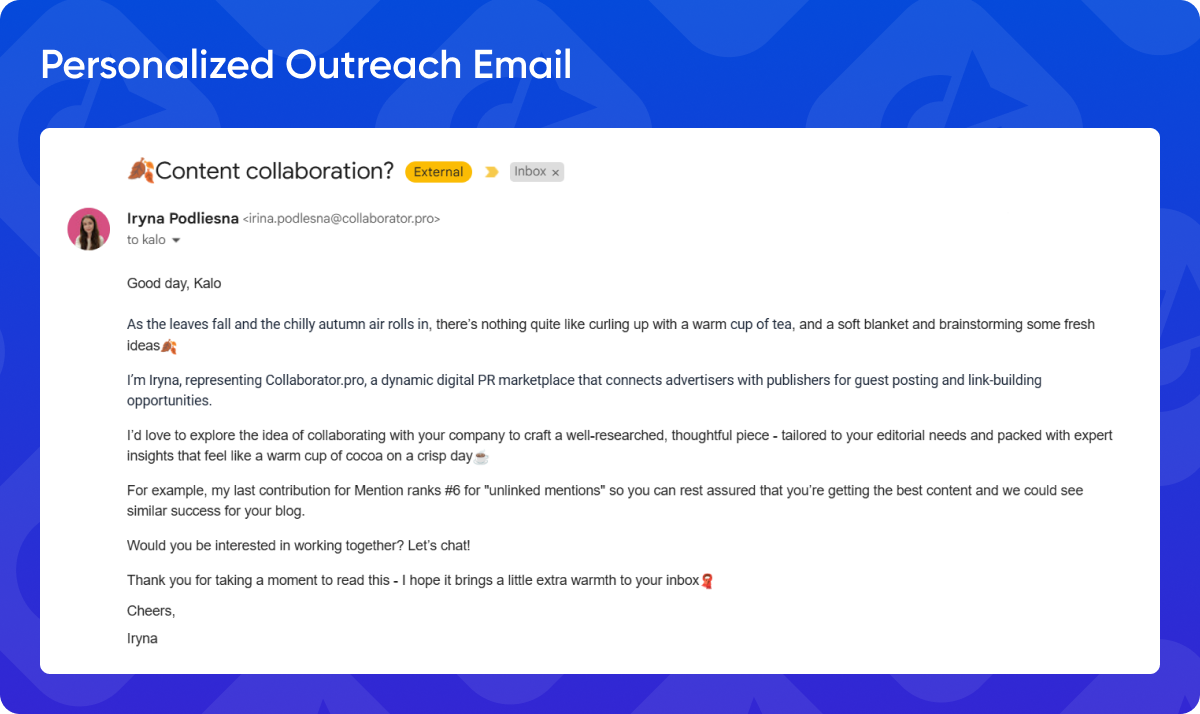
Alternative Link Building Strategies
If you’re looking for alternative link-building strategies that are also inspired by competitor analysis insights, you can try resource page link building. This involves identifying industry-specific pages that list helpful content and suggesting your site as an addition.
Guest posting also remains effective for building backlinks and authority by creating high-value articles for niche blogs, while "guestographics" combine guest posts with infographics for visually engaging content. Additionally, participating in roundups, where websites feature the best resources or expert insights, can help secure quality backlinks and drive targeted traffic to your site.
With "My List" you can analyze your competitors' strategy. Just jump into your Collaborator account, create a new list, and add up to 1000 links or domain URLs. Organizing links has never been easier!
If you're ready to start your link building journey, sign up with Collaborator to find the best opportunities for collaboration.
Step 6: Track, Measure, and Iterate
If you don’t monitor the success of your link-building efforts, you won’t know what works and how to refine your strategies. Data is gold in determining your progress, and you can use it to make data-driven decisions that guide your future SEO strategies.
Using tools like Ahrefs, SEMrush, or even Google Search Console, you can track new backlinks, assess their quality, and ensure they contribute to your authority. These tools can also help you monitor keyword rankings and referral traffic, offering insights into how link building impacts your overall SEO performance.
By regularly analyzing this data, you’ll identify patterns, such as which strategies yield the highest-quality links, and adjust your efforts accordingly. This will maximize the impact of your link building campaigns and ensure you stay ahead of your competitors.
Use Competitive Link Analysis To Get Ahead
Knowing how to spy on competitors' backlinks ethically is an excellent way to educate yourself about what works for your competition. By understanding how they are getting backlinks and why, you can apply similar principles to your SEO strategy. Using competitive analysis tools like Ahrefs, Majestic, and SEMrush simplifies the process and makes enhancing your backlink profile easier, saving you time and helping you rank higher in the SERPs.
To start your own competitive link analysis, you need to choose the tools that best suit your needs, determine which links you want to prioritize and analyze the content those links are built around. When you've done this, you can create content that surpasses your competitors and replicate successful outreach strategies. From there, you’re on the path to success.
Just remember that competitive backlinking is exactly that. It’s a never-ending competition, so you need to continue implementing this tactic into your SEO strategy for lasting results.
Use these strategies to start analyzing your competitors, and take advantage of our free checklists and templates to get (and stay!) ahead.

